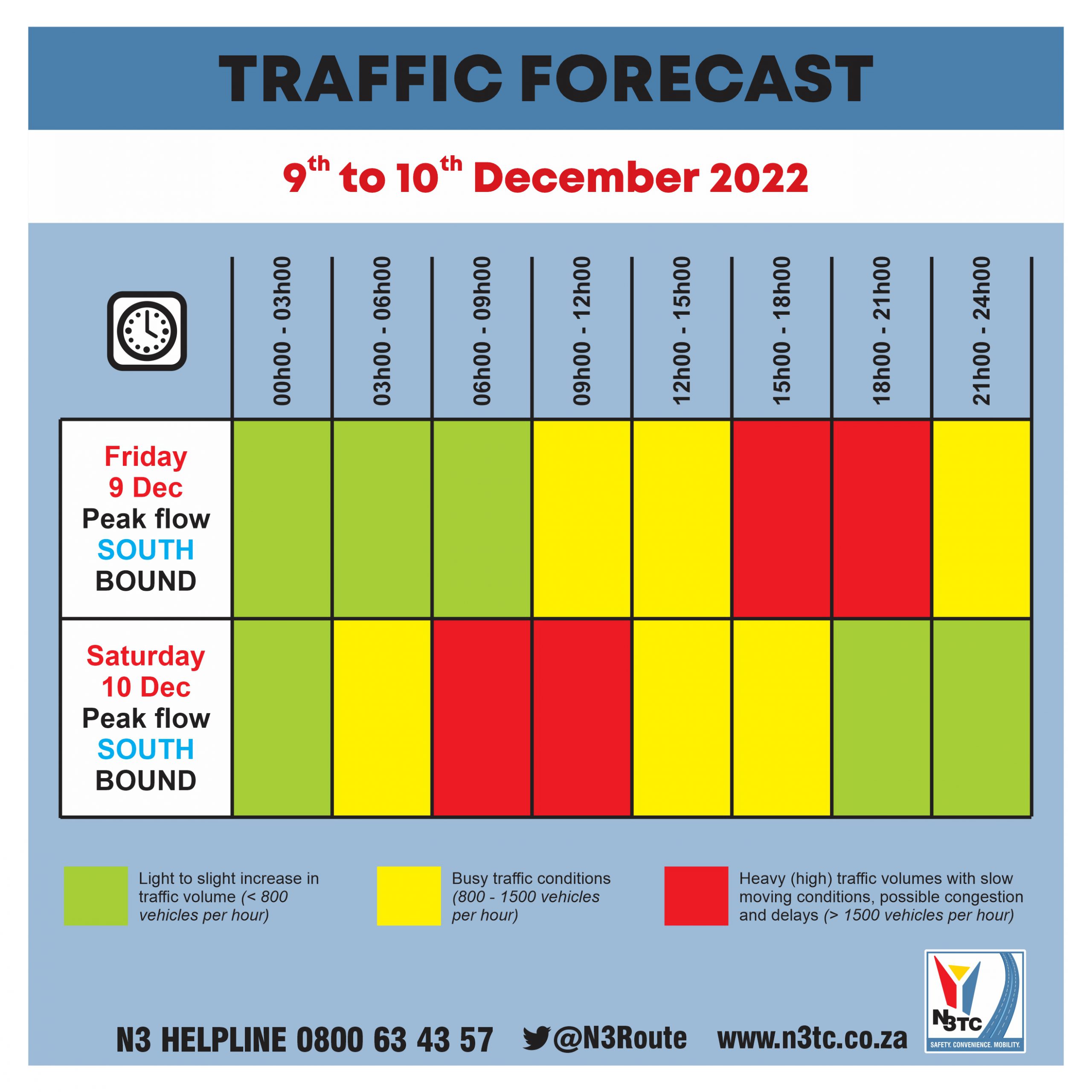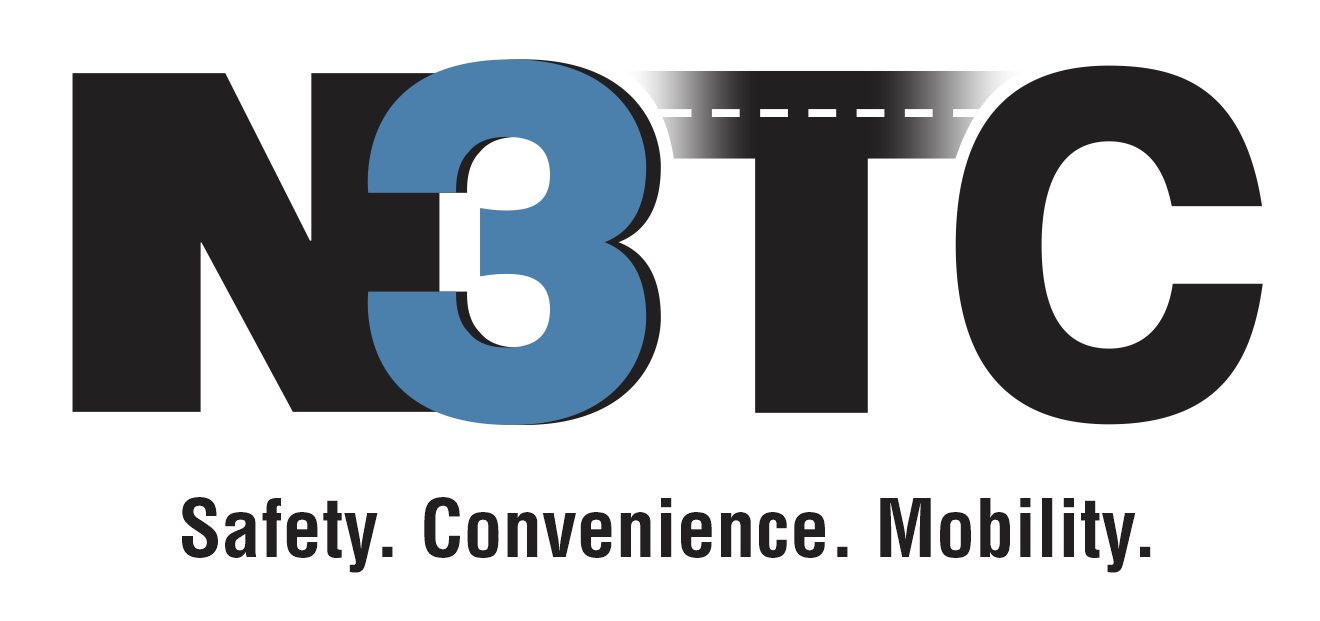Combining leisure travel and freight movement on the N3 transport corridor: N3TC CALLS FOR CAUTION AS TRAFFIC VOLUMES INCREASE ON THE N3 TOLL ROUTE
South Africa relies heavily on its road infrastructure to support daily economic activity. As a result, all manner of freight is currently being transported on our road network to every corner of the country and beyond our borders.
Trucks constitute approximately 44% of all vehicles travelling on the N3 Toll Route daily.
During the past decade, a significant increase (between 8% and 10% per annum) in the number of trucks on the N3 Toll Route has been recorded. This is mainly due to the transfer of freight, especially bulk products, from rail to road. On average, 7000 trucks move thousands of tons of goods on the N3 every day.
In the past, traffic patterns on the N3 Toll Route tended to change over weekends and during peak holiday periods, when public transport and passenger vehicle numbers increased exponentially, and truck traffic declined. However, the most recent traffic studies indicate that freight movement now follows typical weekday patterns.
“Although a slight decrease in truck traffic may be experienced at the height of the festive season, road users should not expect a significant drop in truck traffic over weekends and during holidays. It is, therefore, essential to plan your road trip ahead of your departure, and to stay informed of road and traffic conditions while enroute. This way, you will be better prepared for any eventuality, including possible emergencies and delays,” advises Ms Thania Dhoogra, operations manager of the N3 Toll Concession (N3TC).
N3TC manages a 415-kilometre section of the N3 Toll Route from Cedara in KwaZulu-Natal and Heidelberg in Gauteng. The N3 transport corridor not only links South Africa’s busiest port in Durban to its inland provinces, but also connects large sections of the country’s agricultural, mining, industrial and tourism sectors located in KwaZulu-Natal, the Free State, Mpumalanga and Gauteng.
Managing a primary transport arterial such as the N3 Toll Route requires careful engineering and traffic management, routine road maintenance, regular rehabilitation, and construction to maintain its safety, convenience, and mobility. “We aim to keep traffic flowing as freely and safely as possible, but at peak times, a myriad of challenges including heavy traffic volumes, a mix of vehicle types, crashes, and emergency road repair or maintenance work may contribute to traffic congestion, disruptions and delays,” explains Ms Dhoogra.
CRASH DATA GIVES SAFETY CLUES
N3TC’s crash data assists in the identification of possible road safety threats, and measures that could mitigate these risks.
Crash data from the first ten months of this year (January – October 2022) indicates that 79% of all light motor vehicle crashes and 85% of all truck crashes on the N3 Toll Route can be attributed to driver ineptitude and/or negligence.
The majority (62%) of the crashes recorded on the N3 Toll Route between January and October this year were single-vehicle crashes, where drivers lost control of their vehicles, and their vehicles either left the road or rolled.
On the road, high-risk behaviour and judgment errors come at a steep price. People suffer tremendous physical, emotional, and financial trauma as a result of the carnage on our roads.
Between January and October this year, the four most common types of crashes were vehicles that have rolled (23.3%); vehicles leaving the road (19.4%); damage to plaza infrastructure (14.7%); and head-tail (rear-end) collisions (13.8%).
A total of 1023 crashes were recorded in the first ten months of this year of which 60% involved trucks.
Between 2019 and 2021, the number of truck incidents involving the arrestor beds on Van Reenen Pass increased by 46.4%. This trend continued in 2022 with a further 34 arrestor bed crashes recorded between January and October.
“Arrestor bed incidents are most often the direct result of vehicle mechanical failure. Efforts are underway to curb these incidents through regular vehicle inspections and active law enforcement by the KwaZulu-Natal and Free State Road Traffic Inspectorates,” continues Ms Dhoogra.
SHARING THE ROAD RESPONSIBLY
The current reality (the sheer volume of traffic and a mix of vehicle types sharing the same road) increases road safety risks and impacts the number of crashes on the N3 Toll Route.
Committed efforts are crucial to help reduce hazardous situations. It is a joint responsibility.
The speed differential between heavy- and light motor vehicles is significant. The maximum speed limit for public transport vehicles is 100km/h, and for trucks, the limit is reduced even further to 80km/h. This often causes frustration for light motor vehicle drivers, especially when trucks cause congestion, slow them down, or attempt to overtake them. It is important to remember that trucks and buses require longer stopping distances as a result of their mass, and they can easily jack-knife if forced to brake suddenly. The problem is further compounded by insufficient driver training, long working hours, driver fatigue, lapses in concentration, driver negligence and/or vehicles in poor mechanical order.
Never tailgate trucks and buses. Drivers cannot see vehicles travelling too closely behind them, in their blind spots. Stay well behind trucks and buses to avoid rear-end collisions, and only pass large vehicles if you are certain that the driver can see you in their side view mirrors – never from directly behind.
Extra caution is required around heavy motor vehicles in inclement weather and at night, or when visibility is poor. In wet weather, the splash and spray from trucks and buses make overtaking of heavy vehicles even more dangerous.
A few simple safety measures – such as maintaining a safe following distance; adhering to the speed limit or reducing speed when travel conditions are poor; avoiding U-turns or overtaking on blind rises and solid lines; avoiding distractions; not using mobile devices while driving; always driving sober; and staying focussed, alert, patient and courteous – can make all the difference and help to save lives.
“We appeal to all road users to make it your priority to reduce road safety risks. In this endeavour, we all have to play our part, from government and law enforcement officers to drivers and their passengers, and all logistics and freight operators. It is only through effective law enforcement, safety and security partnerships, preventative measures and swift multi-disciplinary action, when required, that safety and mobility on the N3 Toll Route can be ensured,” stresses Ms Dhoogra.
Expected peak traffic forecast for this weekend.
High traffic volumes of more than 1500 vehicles per hour are expected on the N3 Toll Route in a southbound direction (towards KwaZulu-Natal) on Friday afternoon (09 December) between 15:00 and 21:00, and again on Saturday morning from 06:00 to 12:00.
N3TC highly recommends that road users plan their trips ahead of their departures, and stay informed of road and traffic conditions while travelling on the N3 Toll Route. “Please heed warnings and pay attention to traffic signs,” ends Ms Dhoogra.
On the N3 Toll Route, verified, real-time traffic information and emergency assistance can be obtained from N3TC’s 24-hour helpline: 0800 63 43 57 or by following @N3Route on Twitter.
ENDS.

